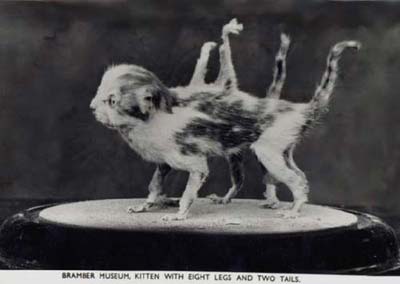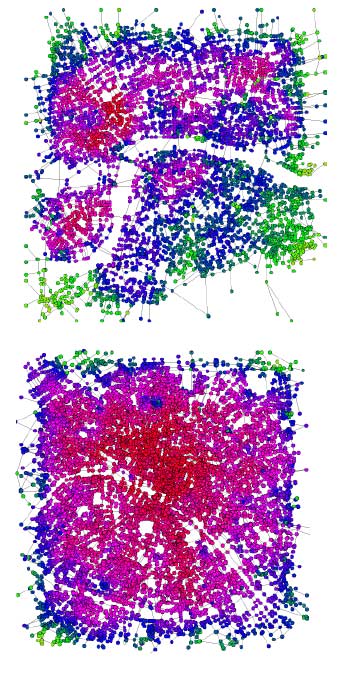 Taser gun used on 10-year-old girl who ‘refused to take shower.’
Taser gun used on 10-year-old girl who ‘refused to take shower.’
Would-be Seattle ninja impaled on fence.
A man whose bowel was damaged in a ‘ripped in half’ motorcycle crash has been fitted with a bionic bottom that enables him to go to the toilet using a remote control.
Malawi: HIV drugs used to ferment local gin and feed poultry.
Russian police have arrested three homeless people suspected of eating a 25-year-old man and selling other bits of the corpse to a local kebab house.
A French woman whose fiance asked her to marry him two days before he was killed in a car crash has been granted a posthumous white wedding.
A British scientist says she is Belle de Jour, the anonymous blogger whose accounts of life as a call girl were turned into books and a TV series.
Live strippers ad campaign halted in Las Vegas.
The curious case of gay-porn-star identical twins.
The cards ask: Do you know who killed me? The South Carolina Department of Corrections started selling these decks in its prison canteens for $1.72 about a year ago. Each card asks that you please call 888-CRIME-SC if you have any information about a case.
German police searched a home in connection with an alleged extortion scheme targeting former supermodel Cindy Crawford and her family.
The father of the boy who once accused Michael Jackson of molestation has committed suicide in NJ.
USPS to end saturday service?
 Nouriel Roubini: “Based on my best judgment, it is most likely that the unemployment rate will peak close to 11% and will remain at a very high level for two years or more.”
Nouriel Roubini: “Based on my best judgment, it is most likely that the unemployment rate will peak close to 11% and will remain at a very high level for two years or more.”
Cheap money and fiscal stimulus seem to have averted a second Great Depression. But policy makers haven’t been able to generate enough spending, public or private, to make progress against mass unemployment. And China’s weak-currency policy exacerbates the problem, in effect siphoning much-needed demand away from the rest of the world into the pockets of artificially competitive Chinese exporters.
A carry trade is when you borrow from a currency with a low interest rate, and then invest in a currency with a higher interest rate. Say the US interest rate is 3%, and the Chinese interest rate is 5%. Borrow at 3%, invest at 5%, make 2%.
The Dow gained more than 53 percent from its March trough, while the S&P is up over 61 percent from its springtime low. That’s just not normal; it’s too much, too soon.
If the economy’s stagnant, why are stocks up? It’s possible that the stock market is just getting it wrong again. Plus: Why the crisis isn’t going away.
Oil production is reaching its limit: The basics of what this means.
The world is running out of uranium and nobody seems to have noticed. The coming nuclear crisis.
The number of Americans who lack dependable access to adequate food shot up last year to 49 million, the largest number since the government has been keeping track.
The nothing-can-be-believed chaos of the financial crisis created a golden opportunity for Zero Hedge, a blog run by a mysterious ex-hedge-funder with a dodgy past and conspiracy theories to burn.
Japanese contractors owed billions by Dubai firms. Related: Burj Dubai – Tallest Tower & Armani Hotel Opening 2009.
Lesbians are better at raising children than conventional couples, a senior member of the Government’s parenting academy has said.
 Patients with empathic, attentive doctors recover more quickly from the common cold.
Patients with empathic, attentive doctors recover more quickly from the common cold.
Men often treat their friends better than women do.
A European study shows that, over time, even the most sophisticated readers can be manipulated.
Most women don’t need a mammogram in their 40s and should get one every two years starting at 50, a government task force said Monday, a major reversal that conflicts with the American Cancer Society’s long-standing position.
Most people know their own vote is hardly worth it when weighed against the effort involved in getting registered and actually going to vote, let alone when weighed against all the other people voting. Why do people bother voting?
Artists have long described the powerful linkage of smell and the past. Why is smell so sentimental?
The world’s biggest single flower attracts insects by mimicking rotting meat.
Floaters are deposits of various size, shape, consistency, refractive index, and motility within the eye’s vitreous humour, which is normally transparent.
How much power does the human brain require to operate?
What are the odds that intelligent, technically advanced aliens would look anything like the ones in films, with an emaciated torso and limbs, spindly fingers and a bulbous, bald head with large, almond-shaped eyes? What are the odds that they would even be humanoid? I argue that the chances are close to zero.
Recent, wistful pictures of the Moon show the Apollo landing sites, including Apollo 11’s lunar module, still resting at the site where it was left 40 years ago. [pics]
The producer who acquired licensing rights to the Winnie-the-Pooh works and characters from A. A. Milne in 1930 has been suing Disney for rights infringement since 1991.
In his brief essay “Gli scacchisti irritabili” (“The
Irritable Chess Players”) of 1985, Primo Levi elaborates a set of symmetries between the act of literary creation and the playing of a game of chess.
Some of the concepts that Kazantzakis attributes to Nietzsche appear to be based on a mistaken interpretation of Nietzsche by Lichtenberger, according to which man is a particle of the divine substance, the eternal Will. For the real Nietzsche, the mysteries of sexuality constitute the only form of eternal life.
If you examine philosophy-department offerings around America, you’ll find staple courses in “Philosophy of Law,” “Philosophy of Art,” “Philosophy of Science,” “Philosophy of Religion,” and a fair number of other areas that make up our world. Why, then, don’t you find “Philosophy of Journalism” among those staple courses?
Adam Smith in 10 minutes.
Brooklyn chef goes ballistic, throws live lobster on patrons, shouts “You think my fish is not fresh? Look how fresh this is!”
As part of a corruption investigation into the Newspaper and Mail Deliverers Union, NYPD officers raided the circulation departments of four major NY newspaper.
New York City webcams.
Even the star that goes on the tree in Rockefeller Center has some work done every once in a while.
 When is the best time of day to break bad news to someone? In the evening.
When is the best time of day to break bad news to someone? In the evening.
Undercover with a Michelin inspector. Conceived in France at the beginning of the last century, the Michelin guide today has editions in twenty-three countries and is one of the best-selling restaurant guides in the world.
An expert’s three-step process to cure your fear of mice.
20 of the most shameless cultural franchises.
The world’s largest book, “Bhutan: A Visual Odyssey Across the Last Himalayan Kingdom,” by Michael Hawley.
Vodafone NZ’s Symphonia features 1000 cellphones syncing 53 different ringtone alerts from 2000 sent messages to reconstruct Tchaikovsky’s 1812 overture.
The definitive guide to becoming a seasoned all-you-can-eat buffeter.
Oxford word of the year: Unfriend (verb). Unrelated: Start using these words.
Ed Benguiat is an American typographer who crafted over 600 typefaces including Tiffany and Bookman. He also designed logotypes for The New York Times, Playboy, the original Planet of the Apes film and Super Fly. Related House Industries typefaces: Ed Benguiat and Planet of the Apes.
How to make your own book in 3,000 simple steps.
Man-Wolf sightings in Wisconsin.
The Mr. Pac-Man Car.
Autocomplete Me.
.–.
Salvador Dali and his anteater in Paris.



























